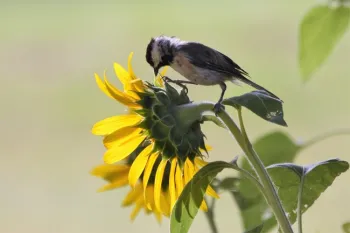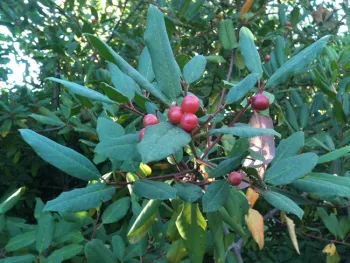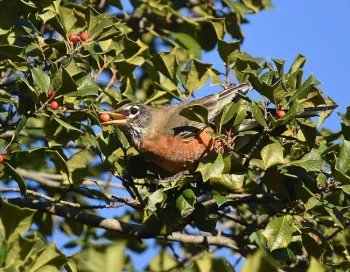
There are three groups of plants that attract birds and each group draws different types of birds: Nectar plants, plants that provide seeds or nuts, and plants that produce berries or fruit. Many plants will provide more than one source of food, i.e., nectar in the spring and berries in autumn.
Here is a list of a few favorite native plants in each group and some of the birds they may attract.
Hummingbirds and Nectar

Hummingbirds prefer tubular shaped flowers that fit the length of their beak, and are bright in color, particularly red. Native salvias (sages), penstemon, columbine, and honeysuckle all serve up nectar for hummingbirds.
- Sages (Salvias): There are about 18 sages native to California, with Hummingbird sage (Salvia spathacea) being one of them. The common name says it all! Fruity scented dark rose-lilac blossoms appear in March – May. It also produces autumn seeds that attract birds such as sparrows and finches.
- Western Redbud (Cercis occidentalis). A small deciduous tree or shrub found in the foothills and mountains of California with distinctive shiny heart-shaped leaves. The showy bright pink or magenta flowers develop in the later winter and spring, growing in clusters all over the shrub, making the plant very colorful and noticeable in the landscape. Goldfinches and sparrows will feed on seeds produced in the fall.
- California Fuchsia (Epilobium canum). There's probably no better California native plant for attracting hummingbirds. A perennial plant, it blooms a bright profusion of scarlet flowers in spring and summer, and is often the only native California flowering plant blooming at the height of summer.
Birds That Eat Seeds

- Bush sunflower (Encelia californica), commonly referred to as "California bush sunflower.” With abundant bright yellow daises, it is beautiful in late winter through summer. Attracts goldfinches, sparrows, orioles, crows, Scrub jays, grosbeaks.
- California aster (Symphyotrichum chilense). A member of the Asteraceae family it is native to western North America. The summer blooming flowers come in blues, purples and yellow colors. It is also a host plant for the Northern Checkerspot, Field Crescent and Pearl Crescent butterflies.
- Deergrass (Muhlenbergia rigens), also known as Meadow Muhly and Deer Muhly, is a summer-growing, perennial bunchgrass whose seeds attracts woodpeckers, finches, grosbeaks, crows and jays.
Berry Plants are Important to Birds

Many shrubs and small trees provide berries that ripen at different times, so providing a seasonal variety, such as cherries for birds during the breeding seasons of spring and summer, and holly in winter, helps sustain birds throughout the year.

- Golden Currant (Ribes aureum). A deciduous plant that blooms in late winter and spring with golden yellow flowers that attract hummingbirds. The ripe berries in autumn are amber yellow to black in color, are edible, and attract a wide range of birds. There are two main varieties: Ribes aureum var. aureum and Ribes var. gracillimum.
- Blue Elderberry (Sambucus Mexicana). Also known as Mexican elderberry, the berries from elderberries are one of the most important sources of food for birds in California. Native from Oregon to Baja all the way to western Texas, it has cream or yellow flowers in the spring and purple berries in the fall.
- Toyon (Heteromeles arbutifolia). Toyon is a beautiful perennial chapparal shrub native throughout the western part of California and the Sierra foothills. It is also known by the common names Christmas berry and California holly from the bright red berries it produces during the winter months, which are produced in large quantities, maturing in the fall and persisting well into the winter. Note: the berries are toxic to humans in large amounts.
- California False Buckthorn (Frangula californica). This perennial, evergreen shrub is also known as Coffeeberry due to its berries containing seeds that resemble coffee beans. The shrub produces small, greenish white flowers in the summer, followed by dark berries that are sought after by birds.
By providing a variety of native plants that produce nectar, seeds and berries to attract different types of birds, you'll be providing a healthy haven for birds all year round, along with many other species of pollinators such as bees and butterflies!
Denise Godbout-Avant has been a UCCE Stanislaus County Master Gardener since 2020.
Resources
California Native Plant Society https://www.calscape.org/ and garden planner https://gardenplanner.calscape.org/
A list of plants that naturally attract California Birds to your Garden https://www.laspilitas.com/bird.htm
Audubon native plants database https://www.audubon.org/native-plants
